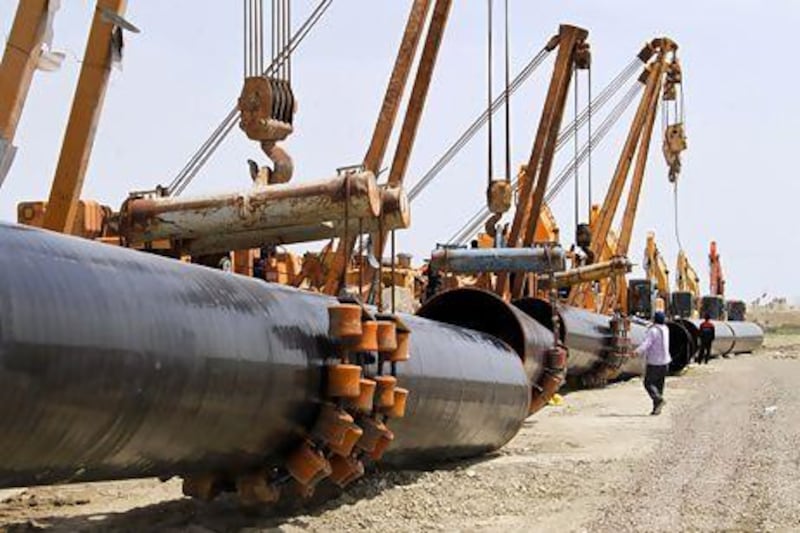Pakistan is facing a conundrum. Led by the prime minister Nawaz Sharif, the new government is being pressed by the United States not to proceed with a US$7.5 billion gas pipeline project with Iran. But gas imported from Iran could avert the worst power crisis in Pakistan's history.
How can Mr Sharif go ahead with what is considered the country's energy lifeline, without damaging its relations with the US?
The US secretary of state John Kerry, during a recent visit to Islamabad, warned energy-deficient Pakistan that the pipeline project could invoke sanctions on the country.
The project was inaugurated by the former Pakistani government led by the president Asif Ali Zardari on March 11. The ground-breaking ceremony, held in the Iranian border city of Chabahar, marked the beginning of work on the 780-kilometre pipeline earmarked for the Pakistani side of the border.
Iran has already completed 900km of pipeline on its side. Furthermore, Tehran has agreed to lend Islamabad US$500 million, a third of the estimated cost of the Pakistani section of the pipeline. Islamabad has already awarded the contract for building its portion to the Iranian company Tadbir Energy. Under the contract, Tadbir Energy is to undertake the construction of the pipeline in Pakistani territory in two phases.
But the project faces stiff opposition from Washington, which has issued Islamabad with several warnings to abandon the pipeline or face sanctions.
The US is opposed to any project with Iran that involves substantial investment, because of western fears that Tehran is planning to build a nuclear arsenal.
Because other countries' companies have lost interest in any Iranian projects amid pressure from the United States, Islamabad and Tehran decided to lay the pipeline using Pakistani and Iranian gas companies.
The pipeline is vital to Pakistan's pressing energy needs. Once completed, it is expected to start delivering gas to Pakistan by December 2014. It would initially transfer 30 million cubic metres of gas per day - enough to bail the country out of its acute energy crisis.
With massive power cuts in major cities and towns on a daily basis, the country is undergoing its biggest energy crisis.
The energy shortage has not only stifled industry, it has also made the lives of 180 million Pakistanis unbearable.
The former government's decision to go ahead with the pipeline is widely believed to be a politically motivated decision taken a few days before the government completed its five-year tenure on March 15. Technically speaking, an outgoing government is not supposed to take such decisions, which could have far-reaching implications not only for the country, but also for the whole region.
Now the ball is in the Sharif government's court. Does it go ahead with the project, defying the US pressure and risking economic sanctions, or does it simply abandon the project and seekWashington's help for an alternative energy project?
The US has worked hard to persuade the Pakistani authorities to shelve the pipeline project and has offered financial and technical assistance to bring about a liquefied natural gas importing plan alongside the construction of the Diamer-Bhasha Dam in the country's north.
Abandoning the pipeline project would, however, be a politically sensitive decision to be taken by a democratic government because it would come at a high political cost.
Mr Sharif's government, which has pledged to end the energy crisis, might choose to expedite work on the pipeline, which would help to generate around 5,000 megawatts of electricity - equivalent to the current peak shortage of power in the country.
The pipeline would have far-reaching geopolitical ramifications. Were it extended to India or China, it would be able to meet the energy demand of other countries as well as Pakistan.
The project was initially planned as an Iran-Pakistan-India pipeline to carry gas from Iran to Pakistan and on to India. New Delhi withdrew in 2009 after coming under pressure from Washington, but India has kept open the option of joining at a later stage. After India's withdrawal, China expressed interest in joining the project.
The pipeline, were it to be finished, could affect demand for Saudi Arabia and UAE energy in South Asia. Pakistan imports about 80 per cent of its oil. The availability of Iranian gas could cut the country's oil imports from the UAE, Saudi Arabia, Kuwait and other oil-producing countries.
Saudi Arabia is reported to have offered Pakistan alternative options to cope with its energy crisis in a move to persuade Islamabad to abandon the Iran pipeline project.
Syed Fazl-e-Haider is a development analyst in Pakistan. He is the author of several books, including The Economic Development of Balochistan





